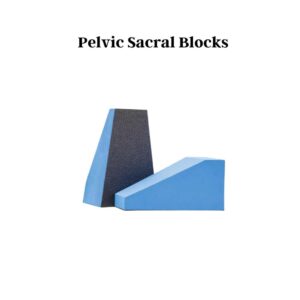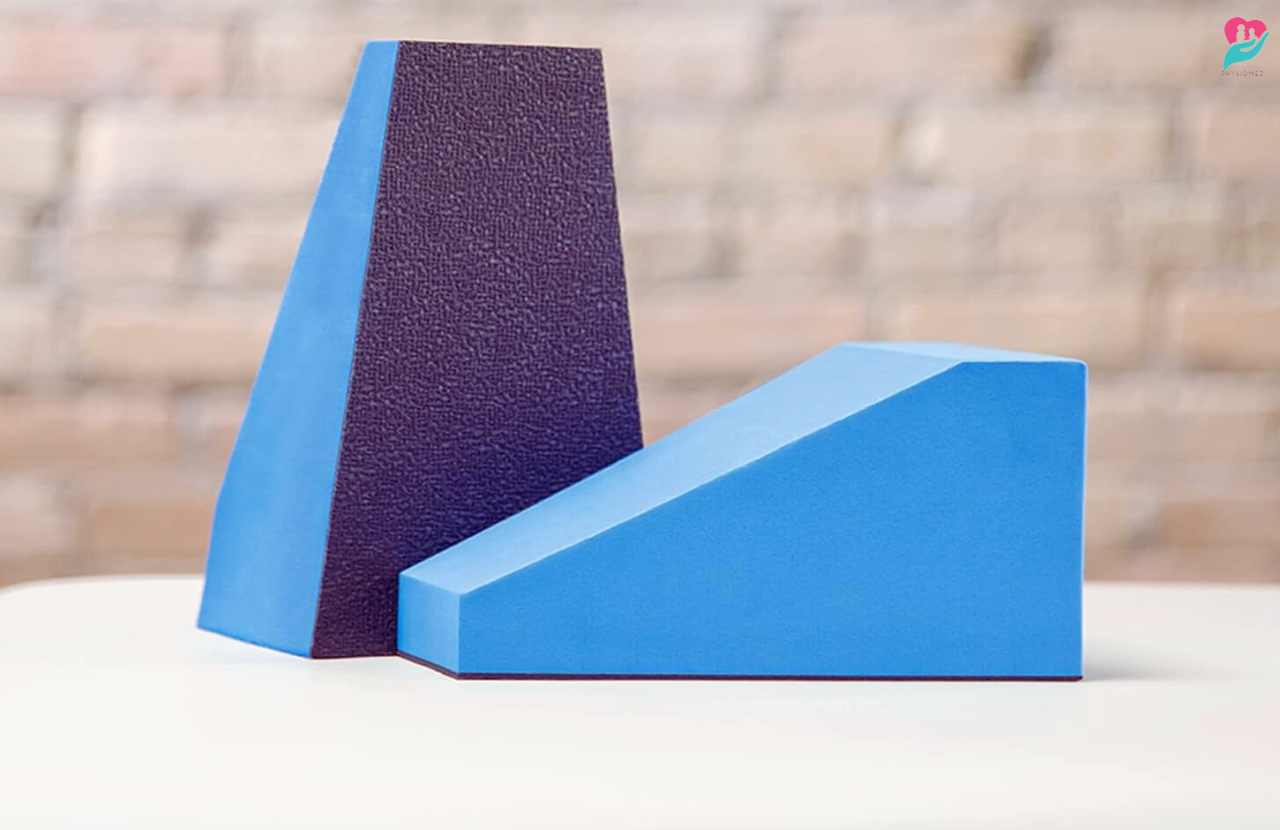To use pelvic sacral blocks, place them under the pelvis to provide support and stability during bodywork or healing practices. When properly positioned, these blocks can help relieve tension and discomfort in the pelvis, lower back, and sacrum, allowing for greater relaxation and alignment.
By using pelvic sacral blocks, you can optimize the effectiveness of various therapeutic techniques, such as massage, yoga, or physical therapy, to address pelvic imbalances or promote overall well-being.
Whether you are recovering from an injury, managing chronic pain, or simply seeking to enhance your self-care routine, incorporating pelvic sacral blocks can offer numerous benefits for your body’s alignment, balance, and relaxation.
Read More: Anterior Pelvic Tilt Brace: Unlocking Your Perfect Posture
What Are Pelvic Sacral Blocks?
Pelvic sacral blocks are a therapeutic technique healthcare professionals use to alleviate pain and promote healing in the pelvic and sacral areas of the body. These blocks involve injecting a local anaesthetic and/or steroid medication into the sacroiliac (SI) joint or related structures.
What are the Purpose of Pelvic Sacral Blocks?
Pelvic sacral blocks are primarily used to diagnose and treat conditions that cause pain and dysfunction in the pelvic region. The injection of medication into the SI joint can help reduce inflammation, relieve pain, and improve mobility. These blocks are commonly used for conditions like sacroiliac joint dysfunction, pelvic girdle pain, and sciatica.
By targeting the specific area of pain, pelvic sacral blocks provide localized relief, allowing patients to resume their regular activities with diminished discomfort. The blocks can be part of a comprehensive treatment plan that includes physical therapy, pain management, and other interventions.

What are the Benefits Of Using Pelvic Sacral Blocks?
Using pelvic sacral blocks can provide several benefits in relieving pain and discomfort. These blocks are designed to promote proper alignment and stability, which is crucial for individuals experiencing pelvic issues.
When the pelvis is misaligned or unstable, it can lead to various problems, such as lower back pain, hip pain, or even radiating pain down the legs. Pelvic sacral blocks help address these issues by providing support and stability to the pelvis, allowing for better alignment.
Many individuals have found relief through the use of pelvic sacral blocks. Several case studies and success stories have documented the positive impact of these blocks on reducing pain and improving overall well-being.
These blocks offer a non-invasive and conservative approach to managing pelvic discomfort, making them popular among individuals seeking natural solutions.
How to Use Pelvic Sacral Blocks?
Here, we will explore how pelvic sacral blocks are used with pre and post-necessity to use the pelvic sacral block.
Assessing Your Needs
Assessing your needs is an important step in using pelvic sacral blocks effectively. Start by identifying the source of your pain or discomfort. It could be related to your lower back, pelvis, or hips. Consulting with a healthcare professional is crucial for a proper assessment.
They can evaluate your symptoms, conduct necessary tests, and diagnose accurately. By understanding the root cause of your pain, you can determine if pelvic sacral blocks are the right treatment option for you. Remember, each individual’s needs may vary, so seeking professional guidance for personalized advice is essential.
Choosing The Right Size And Material
To effectively use pelvic sacral blocks, choosing the right size and material is important based on your specific needs. Different types of pelvic sacral blocks are available, and understanding their differences can help you make an informed decision.
When selecting the appropriate size, consider factors such as your body size and the intended use of the block. Larger blocks provide more support and stability, while smaller blocks offer greater mobility. Choosing a size that comfortably accommodates your body and meets your requirements is essential.
The material of the block is another crucial consideration. Pelvic sacral blocks are typically made from foam or wood. Foam blocks are lightweight and provide cushioning, making them suitable for individuals who require gentle support. On the other hand, wooden blocks are firmer and offer greater stability, making them ideal for those who need more firmness.
Choosing the right size and material for your pelvic sacral block can enhance your practice and optimize your comfort and support during exercises and therapy sessions.
Setting Up A Comfortable Space
Creating a safe and supportive environment is crucial when using pelvic sacral blocks for therapy or treatment. To set up a comfortable space, choosing the right surface and positioning is important. Consider the following tips:
- Choose a firm, level surface that provides stability and support.
- Ensure there are no obstacles or hazards in the area to prevent accidents.
- Position the pelvic sacral blocks to promote proper alignment and relaxation.
- Additional supportive props, such as cushions or bolsters, enhance comfort.
- Maintain a calm and quiet environment to facilitate relaxation and focus.
- Adjust the height and angle of the blocks according to personal comfort and therapeutic goals.
By creating a safe and supportive environment, you can fully engage in the benefits of pelvic sacral block therapy and optimize your overall experience.
Proper Placement And Alignment
Proper placement and alignment of pelvic sacral blocks are crucial for effective use. The blocks should be positioned correctly to ensure optimal support and stability for the pelvis. To achieve this, follow these guidelines:
- Start by locating the dimples at the base of the spine, known as the posterior superior iliac spines (PSIS).
- Place the blocks just below the PSIS, in line with the sacrum.
- Make sure the blocks are parallel to each other and aligned symmetrically with the midline of the body.
- Ensure the blocks are snugly placed against the sacrum, providing firm support.
- Verify that the patient’s weight is evenly distributed on both blocks to avoid imbalances.
- Adjust the position of the blocks if necessary, ensuring the patient feels comfortable and stable.
By following these placement and alignment guidelines, you can effectively use pelvic sacral blocks to provide the necessary support and alignment to the pelvis, promoting stability and proper posture.
Adjusting Intensity And Duration
To adjust the intensity and duration when using pelvic sacral blocks, it is recommended to start with gentle pressure and gradually increase it. This allows your body to acclimate to the support and prevents discomfort or strain. Begin by placing the blocks under your pelvis and applying light pressure. As you become more accustomed, you can slowly increase the pressure to find the level that provides optimal support. It’s essential to listen to your body and make adjustments accordingly.
Regarding the duration of using pelvic sacral blocks, it is best to consult with a healthcare professional or therapist for personalized guidance. They can assess your needs and recommend an appropriate duration for your circumstances. Everyone is different, so what works for one person may not necessarily work for another.
Listening To Your Body
Recognizing signs of discomfort or strain is crucial to using pelvic sacral blocks effectively. It is important to listen to your body and pay attention to any sensations of discomfort or strain during the practice. Adjusting your unique needs can help prevent any potential injury or further discomfort. Whether new to using pelvic sacral blocks or have been using them for a while, you must be aware of your body’s signals and adjust accordingly. Doing so can ensure a safe and beneficial practice that caters to your specific requirements and limitations.
Recap
Recap of the benefits and safe usage of pelvic sacral blocks:
- Improves pelvic alignment: Pelvic sacral blocks help realign the pelvis, reducing discomfort and promoting better posture.
- Relieves back and hip pain: These blocks can alleviate pain in the lower back and hips by providing support to the sacrum.
- Aids in pelvic floor therapy: Pelvic sacral blocks are commonly used in conjunction with pelvic floor exercises to enhance the effectiveness of therapy.
- Enhances yoga poses: Yoga practitioners can utilize pelvic sacral blocks to deepen stretches and achieve better alignment during poses.
- Safe and easy to use: Pelvic sacral blocks are generally considered safe, but it’s important to consult a healthcare professional to ensure correct usage.
How to Use Pelvic Sacral Blocks Video
Frequently Asked Questions
How To Do Pelvic Blocking?
Pelvic blocking can be done by placing a block or cushion between your knees to align the pelvis. This helps stabilize the lower back and hips during exercises and stretches. Keep the knees in line with the hips and ankles while performing movements.
Do Pelvic Blocks Work?
Pelvic blocks can help to correct misalignment and relieve pain by supporting the pelvis. Chiropractors and physical therapists commonly use them. However, their effectiveness may vary depending on the individual. It is best to consult a healthcare professional to determine whether pelvic blocks suit your specific condition.
How Can I Realign My Pelvis At Home?
To realign your pelvis at home, try these simple exercises:
- Pelvic tilts: Lie on your back, bend your knees, and tilt your pelvis up and down.
- Hip stretches: Sit with crossed legs and gently push your knees toward the floor.
- Glute bridges: Lie on your back, bend your knees, and raise your hips.
- Hip adductor stretch: Sit with your legs wide and lean forward to stretch your inner thighs.
- Quadruped exercises: Get on all fours and raise and lower your opposite arm and leg alternately.
Remember, consult a healthcare professional before starting any new exercise routine.
How Do Chiropractors Use Blocks?
Chiropractors use blocks to enhance spinal adjustments and position patients for better alignment. By placing blocks under specific parts of the spine, chiropractors can create a more effective adjustment and improve spinal health.
Conclusion
Using pelvic sacral blocks can be an effective way to alleviate pain and discomfort in the pelvic area. These blocks can help correct imbalances and improve posture by providing support and aligning the pelvis. Incorporating these blocks into your daily routine can relieve and enhance overall well-being.
So, whether you’re dealing with back pain, hip pain, or pregnancy-related discomfort, consider trying pelvic sacral blocks. Experience the benefits for yourself and enjoy a more balanced and pain-free life.

